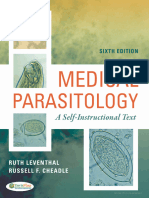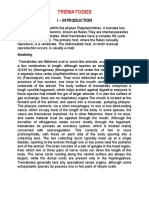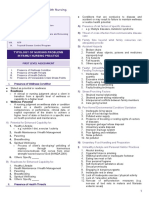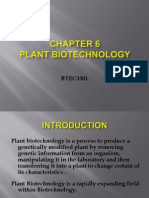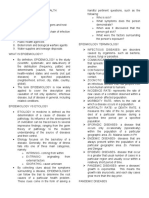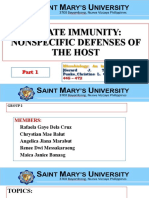Infographic A Brief History of Microbiology PDF
Infographic A Brief History of Microbiology PDF
Uploaded by
Cristian MéndezCopyright:
Available Formats
Infographic A Brief History of Microbiology PDF
Infographic A Brief History of Microbiology PDF
Uploaded by
Cristian MéndezOriginal Title
Copyright
Available Formats
Share this document
Did you find this document useful?
Is this content inappropriate?
Copyright:
Available Formats
Infographic A Brief History of Microbiology PDF
Infographic A Brief History of Microbiology PDF
Uploaded by
Cristian MéndezCopyright:
Available Formats
A Brief History of Microbiology
The Advent of An
1886: Theodore Escherich
Laying the Foundation
describes a bacterium which
he called “bacterium coli
tibiot
commune” and which was
later to be called Escherichia
coli. A strain he isolated in 1920s: Selman
ics
1886 is added to Waksman and Albert 1928: Alexander Fleming
the collection 1900: Almwroth Wright 1915: Isolation of the very Schatz lead a systematic accidentally discovers
upon its founding isolates NCTC 160 Salmonella first bacterial strain registered effort to screen soil penicillin. He returns from 1930s: NCTC introduces
(NCTC 86). enterica subsp. enterica in the collection. NCTC 1 is bacteria for antimicrobial vacation and notices that a freeze-drying of samples
serotype Typhi from the a strain of Shigella flexneri compounds. NCTC later
1890: German scientist culture plate left lying out to ensure longevity and
spleen of a typhoid patient recovered from Private Ernst acquires the Streptomyces
Robert Koch provides proof of had become overgrown streamline storage and
during the Boer War. His Cable, a WWI soldier who griseus strain (NCTC 4523)
germ theory by injecting pure with staphylococci colonies, shipment.
Our understanding of cultures of the Anthrax bacilli
wartime experiences later
lead him to
died from dysentery. It is
resistant to penicillin
from which they isolated except where mold was
1887: Julius Petri invents streptomycin. growing. He explores further
microbiology has evolved into mice. persuade the and erythromycin after his former assistant
the agar-coated glass dish armed forces to even though it was 1st Merlin Price reminds him,
enormously over the last for culturing bacteria; earlier produce 10 million isolated before “That’s how you discovered 1930s: Fritz Kauffman and
attempts at culturing involved vaccine doses for the discovery of 1920: NCTC is
150 years. Few institutions potato slices WWI troops in antibiotics. established to “provide
lysozyme.” Over the next 20
years, Fleming deposits 16
Phillip White co-develop
a scheme for classifying
and gelatin. northern France.
have witnessed our a trustworthy source of
authentic bacteria for
samples with NCTC, salmonellae by serotype.
including a sample
collective progress more use in scientific studies.” of Haemophilus
Frederick William influenza isolated
closely than the National Andrewes deposits the from his own nose in
first cultures.
Collection of Type Cultures November 1935.
(NCTC). In fact, the
collection itself is a record
of the many milestones
microbiologists have
Marshalling Science for
crossed, building on the 1977: Gilbert and Sanger Public Health 1941: Howard Florey and
Ernest Chain begin mass
TA
discoveries of those who independently develop production of penicillin
CG
methods to determine the with funds from the US
came before. exact sequence of DNA CT 1969: Don Brenner and colleagues
GT establish DNA hybridization as a more 1947: Edward Tatum and and British governments
molecules. A Joshua Lederberg produce the after the bombing of Pearl
reliable basis for classifying clinical
isolates of Enterobacteriaceae. He 1961: NCTC curator Samuel first gene map of E. coli K12 Harbor. By D-Day in 1944,
To date, 60% of NCTC’s uses the new method to replace Cowan and Kenneth Steel 1949: NCTC begins a 10- (NCTC 10538). Despite being enough penicillin has
publish ‘Diagnostic Tables for year effort to characterize every one of the most intensively been produced to treat all
type strains with more representative
historic collection now has 1977: CDC researchers Joseph McDade and specimens and identify numerous new the Common Medical Bacteria’ organism in the collection. studied organisms in the 20th wounded Allied Forces.
Charles C. Shepard isolate Legionella microbial species, including Moellerella in the Journal of Hygiene. century, no one definitively
a closed, finished reference pneumophilia (NCTC 11230 and wisconsensis (NCTC 12132), Leminorella Demand is so great the journal knows why it is called “K12”.
reprints and distributes them in
genome, thanks to PacBio® 11192) as the bacterial pathogen
behind the outbreak of a new
grimontii (NCTC 12152), Enterobacter
asburiae (NCTC 12123), and Citrobacter pamphlet form. The work forms
the basis of Cowan & Steel’s
Single Molecule, Real- pulmonary disease at a convention in braakii (NCTC 13630).
Manual for the Identification 1953: Pioneering food 1947: NCTC focus shifts from 1942: Florey and Chain
Philadelphia.
Time (SMRT®) Sequencing. of Medical Bacteria, first
published in 1965 and a bench-
safety microbiologist a general microbial collection contribute three Bacillus
Betty Constance Hobbs to bacteria of medical or strains (NCTC 6431, 6432,
We are excited to be top staple for years to come. publishes a study establishing veterinary interest. and 6474) thought to
Clostridium perfringens as the produce ‘antibacterial
their partner in crossing cause of many outbreaks of substances active against
food poisoning. She eventually the Staphylococcus,’
this latest milestone on deposits more than 20 NCTC demonstrating the
their quest to improve strains of bacteria associated
with food-borne illness.
researchers were even
then seeking
human and animal health antibiotics
by understanding the The Genomi beyond
cs Era
penicillin.
microscopic world.
1981: The European
Culture Collections’ 1987: The first automated 2003: Cornell
Organization, of which DNA sequencing instrument, University scientists
invented by Lloyd Smith, is led by Watt Webb 2011: PacBio ships its first commercial
NCTC is a member, is SMRT Sequencing system, introducing
established. commercialized by Applied and Harold Craighead
Biosystems. publish the first report scientists to the long-read sequencing 2014: NCTC and Wellcome Sanger
of using arrays of zero- platform that will ultimately become the gold Institute (WSI) launch a five-year
mode waveguides standard for generating complete, closed project to sequence 3,000 bacterial
for single-molecule microbial genomes. strains from the collection using PacBio
1982: Future Nobel Prize sequencing.
winner Barry Marshall drinks The largest recorded outbreak of foodborne sequencing technology.
a culture of the Helicobacter 1995: Craig Venter, Hamilton Smith, Claire hemolytic-uremic syndrome, eventually linked Sanger scientists
pylori (NCTC 11638 and Fraser, and colleagues at TIGR elucidate to German-grown sprouts, occurs in Europe. publish the genome
11639) to prove his theory the first complete genome sequence of a The organism responsible, a Shiga toxic E. coli of NCTC 1, generated with SMRT
that most microorganism, Haemophilus influenza, and (NCTC 13562). Sequencing, and compare it to other
stomach submit the sequence to NCBI. S. flexneri isolates collected in 1954, 2018: NCTC scientists Sarah
ulcers are 1984, and 2002. Alexander and Mohammed-
caused by Abbas Fazal complete the
bacteria. extraction of DNA from more
www.pacb.com/microbe than 3000 NCTC species and
samples are delivered to WSI
for sequencing using PacBio
technology.
PN: INF103-061919
You might also like
- Bact211 Answer Key Long ExamDocument1 pageBact211 Answer Key Long ExamKristine PangahinNo ratings yet
- Microbial Physiology Laboratory Activity #2Document4 pagesMicrobial Physiology Laboratory Activity #2Abby LuceroNo ratings yet
- Cholera: Dr. Priyanka SachdevaDocument71 pagesCholera: Dr. Priyanka Sachdevapriyanka100% (1)
- Answers MagazineDocument17 pagesAnswers MagazineBrenda ShakarianNo ratings yet
- Gene ConceptDocument80 pagesGene ConceptPrince HamdaniNo ratings yet
- PDFDocument120 pagesPDFSophia Sofia SahouliNo ratings yet
- Prelims - Clinical ParasitologyDocument15 pagesPrelims - Clinical ParasitologyJyne CatipayNo ratings yet
- Hand Hygiene and The Prevalence and Intensity of AscariasisDocument19 pagesHand Hygiene and The Prevalence and Intensity of AscariasisHanisha EricaNo ratings yet
- MICRO Lecture 1 Introduction To Microbiology and Parasitology 1 PDFDocument29 pagesMICRO Lecture 1 Introduction To Microbiology and Parasitology 1 PDFJireh AcabalNo ratings yet
- Oral Revalida ReviewerDocument10 pagesOral Revalida RevieweranneNo ratings yet
- Levanthan Short Ans KeyDocument42 pagesLevanthan Short Ans Keyxyab.varga.swuNo ratings yet
- Classification of ProtozoaDocument1 pageClassification of ProtozoaSalil ShauNo ratings yet
- Medical ProtozoologyDocument6 pagesMedical ProtozoologyRaymund MontoyaNo ratings yet
- Species ConceptDocument2 pagesSpecies ConceptMayhaaa100% (1)
- Unit 11 Role of Fungi in Human Welfare: ObjectivesDocument12 pagesUnit 11 Role of Fungi in Human Welfare: Objectivessivaram888No ratings yet
- Medical Parasitology in The Philippines (Belizario, de Leon) - Pages-307-340Document34 pagesMedical Parasitology in The Philippines (Belizario, de Leon) - Pages-307-340Mae Rose Charlene MendozaNo ratings yet
- P O I A V: Reason For Selecting Garden Pea PlantDocument22 pagesP O I A V: Reason For Selecting Garden Pea PlantDr. Remya RanjithNo ratings yet
- BlastulaDocument4 pagesBlastulaCyanDesNo ratings yet
- 1096-Article Text-4657-1-10-20200205Document8 pages1096-Article Text-4657-1-10-20200205MELNo ratings yet
- Balantidium ColiDocument17 pagesBalantidium ColiRafel SaherNo ratings yet
- Applications of BiosystematicsDocument13 pagesApplications of BiosystematicsKrizia Corrine St. PeterNo ratings yet
- Vaccine and ImmunityDocument32 pagesVaccine and ImmunityAlona SangamNo ratings yet
- Lecture 3 - Intro. To MetazoaDocument30 pagesLecture 3 - Intro. To MetazoaGammee Or100% (1)
- Cestodes: 1. Taenia Solium (Pork Tapeworm) & Taenia Saginata (Beef Tapeworm)Document18 pagesCestodes: 1. Taenia Solium (Pork Tapeworm) & Taenia Saginata (Beef Tapeworm)Genevee Ryeleen DelfinNo ratings yet
- S4 L5 SchistosomaDocument5 pagesS4 L5 Schistosoma2013SecBNo ratings yet
- pm2 TREMATODESDocument39 pagespm2 TREMATODESshastaNo ratings yet
- Trematodes: I - IntroductionDocument4 pagesTrematodes: I - IntroductionjisooNo ratings yet
- Merged PDF 2021 11 16T12 - 01 - 01Document15 pagesMerged PDF 2021 11 16T12 - 01 - 01Ericsson CarabbacanNo ratings yet
- Ancylostoma DuodenaleDocument17 pagesAncylostoma DuodenaleZee FaaizaNo ratings yet
- Anatomy and Physiology Case PresentationDocument3 pagesAnatomy and Physiology Case PresentationVito VitoNo ratings yet
- The Amiel Tison Neurological AssessmentDocument18 pagesThe Amiel Tison Neurological Assessmentshaik saifuddin100% (1)
- Membrane Models: Gorter and Grendel's Membrane Theory (1920)Document5 pagesMembrane Models: Gorter and Grendel's Membrane Theory (1920)Hafiz AhmadNo ratings yet
- Chap 14 Micropara ReviewerDocument25 pagesChap 14 Micropara RevieweryanNo ratings yet
- Importance of MicrobiologyDocument10 pagesImportance of MicrobiologyAbdul QadirNo ratings yet
- VaccinationDocument39 pagesVaccinationhaddi awanNo ratings yet
- Week 4 CPH LEC - Introduction To Epidemiology: Fundamentals of Epidemiology in Public Health PracticeDocument11 pagesWeek 4 CPH LEC - Introduction To Epidemiology: Fundamentals of Epidemiology in Public Health PracticeQueency DangilanNo ratings yet
- (ANA) 4.01 Abdomen in General - Dr. ElevazoDocument22 pages(ANA) 4.01 Abdomen in General - Dr. ElevazopasambalyrradjohndarNo ratings yet
- Hierarchical Classification: Linnaean HierarchyDocument3 pagesHierarchical Classification: Linnaean HierarchyanunglaNo ratings yet
- Giardiasis PDFDocument14 pagesGiardiasis PDFSaad Motawéa0% (1)
- Unit 5 Bacterial Structure - Cell Wall 2020 PDFDocument59 pagesUnit 5 Bacterial Structure - Cell Wall 2020 PDFhellokittyNo ratings yet
- Microbial Physiology LectureDocument88 pagesMicrobial Physiology LectureDaniNo ratings yet
- Morpholofy of MoDocument44 pagesMorpholofy of MoPathumavathy RamanathanNo ratings yet
- Midterm Exam Antiinfective, Biotic, ViralDocument5 pagesMidterm Exam Antiinfective, Biotic, ViralJojo Justo100% (2)
- First Level Assessment: Typology of Nursing Problems in Family Nursing PracticeDocument29 pagesFirst Level Assessment: Typology of Nursing Problems in Family Nursing PracticeMary Claire ReyesNo ratings yet
- Protozoa NotesDocument8 pagesProtozoa NotesJayson B. Sanchez100% (1)
- Group 5 - Experiment No.10 - Culture and SensitivityDocument11 pagesGroup 5 - Experiment No.10 - Culture and SensitivityPMG BrightNo ratings yet
- Plant Pathology ScientistDocument16 pagesPlant Pathology ScientistParvendra Yadav YadavNo ratings yet
- "Hemoflagellates Species": Trypanos Oma CruziDocument3 pages"Hemoflagellates Species": Trypanos Oma CruziJ Pao Bayro - LacanilaoNo ratings yet
- The Efficacy of Piper Betle Linn Against Methicillin Resistant Staphylococcus Aureus and Vancomycin-Resistant EnterococcusDocument20 pagesThe Efficacy of Piper Betle Linn Against Methicillin Resistant Staphylococcus Aureus and Vancomycin-Resistant EnterococcusClaire GonoNo ratings yet
- Prefinals 301 ReviewerDocument21 pagesPrefinals 301 ReviewerDjayNo ratings yet
- Surface Anatomy: The Language of AnatomyDocument5 pagesSurface Anatomy: The Language of AnatomyHitagi CrabNo ratings yet
- Zinsser Microbiology PDFDocument2 pagesZinsser Microbiology PDFsccortesNo ratings yet
- Klebsiella Pneumoniae Case ReportDocument3 pagesKlebsiella Pneumoniae Case ReportMaria Chacón CarbajalNo ratings yet
- Bbio Quiz 1&2Document105 pagesBbio Quiz 1&2LAICA SVENSSONNo ratings yet
- Chapter 6 Plant BiotechnologyDocument39 pagesChapter 6 Plant BiotechnologyInuyashayahooNo ratings yet
- Epidemiology and Public HealthDocument2 pagesEpidemiology and Public HealthLady DanielleNo ratings yet
- Module-3 MicrotaxonomyDocument16 pagesModule-3 MicrotaxonomyMary Joy Annika MagtibayNo ratings yet
- Model Projct On Azolla Cultivation PDFDocument8 pagesModel Projct On Azolla Cultivation PDFsanat kr pratiharNo ratings yet
- Health Assessment ToolDocument3 pagesHealth Assessment ToolGail GenturalezNo ratings yet
- Infographic A Brief History of MicrobiologyDocument1 pageInfographic A Brief History of MicrobiologyJhon Rey LagosNo ratings yet
- Activity Completion in Crafting The Annual Implementation Plan (Aip)Document8 pagesActivity Completion in Crafting The Annual Implementation Plan (Aip)NEIL DUGAYNo ratings yet
- Database Planning Design and Administration Chapter9Document8 pagesDatabase Planning Design and Administration Chapter9Anoj SureshNo ratings yet
- 14 Plastic ProcessingDocument20 pages14 Plastic Processingrkd2743No ratings yet
- Lecture 5 - Canned Cycle-TurningDocument11 pagesLecture 5 - Canned Cycle-TurningAditya RatleyNo ratings yet
- 9701 Chemistry November 2014 Examiner ReportDocument46 pages9701 Chemistry November 2014 Examiner ReportAanas Ibtihaz SayedNo ratings yet
- Prevé 1.6 (AT) PREMIUM CFE: Parts Details PriceDocument1 pagePrevé 1.6 (AT) PREMIUM CFE: Parts Details Pricebluhound1No ratings yet
- Delhi Public School, Srinagar: Chapter 5 IndustriesDocument5 pagesDelhi Public School, Srinagar: Chapter 5 Industriesat35No ratings yet
- Current Practice - Diabetic Ketoacidosis in ChildrenDocument10 pagesCurrent Practice - Diabetic Ketoacidosis in Childrenv_vijayakanth7656No ratings yet
- Technology InfographicsDocument22 pagesTechnology InfographicsCALICA , KAYLA MAE S.No ratings yet
- Inventing The Classics - Modernity, National Identity, and Japanese Literature - Free Download, Borrow, and Streaming - Internet ArchiveDocument1 pageInventing The Classics - Modernity, National Identity, and Japanese Literature - Free Download, Borrow, and Streaming - Internet ArchiveCarrasquilloNo ratings yet
- Cavitation in Diesel InjectorsDocument226 pagesCavitation in Diesel Injectorsfivos_rgNo ratings yet
- English Coursework Gcse Creative WritingDocument6 pagesEnglish Coursework Gcse Creative Writingafazbjuwz100% (2)
- Who Taught Dilgo Khyentse Rinpoche TsaluDocument10 pagesWho Taught Dilgo Khyentse Rinpoche TsaluJon DilleyNo ratings yet
- Polydispersity Index From Linear Viscoelastic Data: Unimodal and Bimodal Linear Polymer MeltsDocument36 pagesPolydispersity Index From Linear Viscoelastic Data: Unimodal and Bimodal Linear Polymer MeltsManel KOUBAANo ratings yet
- My Research ProposalDocument44 pagesMy Research ProposalMbeng Conrad WamNo ratings yet
- Lazarus Long On Duty and HumansDocument7 pagesLazarus Long On Duty and HumansPaul Richardson100% (2)
- Scullion 1984 Märchen, Sage, Legende - Towards A Clarification of Some Literary Terms Used by Old Testament ScholarsDocument17 pagesScullion 1984 Märchen, Sage, Legende - Towards A Clarification of Some Literary Terms Used by Old Testament ScholarsmaletrejoNo ratings yet
- Data Sheet 6GK7343-1EX30-0XE0: Transfer RateDocument5 pagesData Sheet 6GK7343-1EX30-0XE0: Transfer RateSukrija RazicNo ratings yet
- Headsets Volume 1 Issue 1Document15 pagesHeadsets Volume 1 Issue 1JUAN GONZALEZNo ratings yet
- Poweroof - Mono Quotation 5 KW 1PhDocument5 pagesPoweroof - Mono Quotation 5 KW 1PhShalinsha SolarizationNo ratings yet
- CIDB MyCESMM Library of Standard DescriptionsDocument173 pagesCIDB MyCESMM Library of Standard Descriptionskiet eelNo ratings yet
- 2014 - Millward Brown - The Power of Being Meaningful Different SalientDocument4 pages2014 - Millward Brown - The Power of Being Meaningful Different SalientJoaquín OríaNo ratings yet
- CHAPTER 16 - Innate ImmunityDocument130 pagesCHAPTER 16 - Innate ImmunityElenor May Chantal MessakaraengNo ratings yet
- Commands: Area Command Description And/or ExampleDocument4 pagesCommands: Area Command Description And/or Examplemanikanta100% (2)
- Basic Guide MandalaDocument19 pagesBasic Guide MandalaEvelyn Read100% (10)
- 303 Binary SearchDocument69 pages303 Binary Searchsaiajay406No ratings yet
- Sylvania Fluorescent Starters COP 40-400 Bulletin 1964Document2 pagesSylvania Fluorescent Starters COP 40-400 Bulletin 1964Alan MastersNo ratings yet
- Strategic Service VisionDocument44 pagesStrategic Service VisionKannan RangaswamiNo ratings yet
- Pumps and Pumping StationsDocument10 pagesPumps and Pumping Stationskpostulart100% (2)










